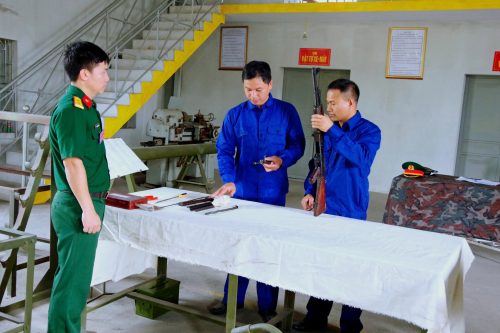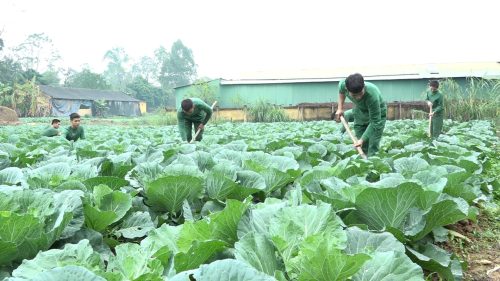Division 304 is one of the first main divisions of our Vietnam People’s Army (VPA), with its recorded brilliant achievements and glorious tradition. In 2023, under the line on building an “adept, compact, strong” VPA towards modernity by the Central Military Commission (CMC) and the Ministry of National Defence, the Division was transferred from Army Corps 2 to Military Region 2. A part from favourable opportunities, this significant transformation has posed new challenges to the Division. In response to higher task requirements, the Division’s Party Committee and Command have taken synchronised measures to quickly stabilise the Division’s organisational structure, comprehensively perform all tasks, and resolutely prevent force adjustments from affecting troops’ ideology and task performance, thereby gaining good results, especially in logistics - technical work. Thanks to efforts made by all cadres and soldiers, in 2024, the Division fulfilled and even surpassed its objectives and targets of logistics - technical work, opportunely providing support for training, combat readiness, and other tasks, particularly its contingency missions; troops’ living conditions and health were maintained and improved. That has also created a new incentive for cadres and soldiers to keep their mind on their work and contribute to building an “exemplarily, typically” comprehensively strong Division.
 |
| Inspecting weaponry maintenance work |
To obtain those good results, first of all, the Division has strengthened all-level party committees and commands’ leadership and direction over logistics - technical work and promoted the core role of its logistics - technical affiliates in this work. Fully aware of the importance of logistics - technical support to performing its tasks, the Division has required its offices and units, especially all-level party committees, commands, and logistics - technical staff to grasp and effectively execute directives and resolutions, with a focus on Resolution 1656-NQ/QUTW and Resolution 1658-NQ/QUTW, dated 20 December 2022, by the CMC on logistics - technical work towards 2030 and beyond as well as relevant directives and plans by the Military Region Command. Those documents have been concretised into resolutions and action plans in accordance with offices and units’ task requirements. Significance has been attached to formulating lines and measures to raise the quality and effectiveness of logistics - technical work. Notably, the Division has directed its competent agencies to review, design, and complete the system of working, leading, and guiding regulations and documents for logistics - technical specialities in accordance with the merger of logistics and technical offices. In the process, the Division has required its offices and units to well perform political and ideological education work and regularly renew methods of leadership, education, and propagation to achieve a huge positive change in awareness and a sense of responsibility among their cadres, employees, and soldiers towards the role of logistics - technical support. At the same time, ideological work has been closely combined with personnel work and policy work to grasp troops’ ideological developments and ensure policies for logistics - technical staff. To meet its task requirements, the Division has directed its affiliates to design and consolidate a system of regular and combat readiness logistics - technical documents at all levels under regulations. At the same time, measures to closely manage logistics - technical reserves for combat readiness have been adopted, while materials and means have been prepared to take part in natural disaster prevention and control and search and rescue under projects assigned by the Military Region as well as in all possible situations.
There is a fact that the Logistics Sector and the Technical Sector are relatively independent from each other due to their own particularities; education and training programs for cadres from the two sectors have yet to be supplementary to each other. Hence, there have been difficulties in command over support work after merger. To settle those issues, the Division has attached importance to building and cultivating a contingent of logistics - technical cadres, employees, and soldiers in accordance with new developments in support work. While selecting and deploying its officers and employees to education and training facilities, the Division has regularly encouraged its logistics - technical staff’s self-study to improve their knowledge and actively organised meetings to exchange experience and knowledge between cadres who had been trained in logistics and technical domains. In the upcoming time, the Division will direct its competent offices to develop training plans for each speciality and cooperate with the Military Region’s Logistics - Technical Department to hold refresher courses for its logistics - technical staff at all levels.
 |
| Crop husbandry across the Division |
In addition to building, consolidating, and retraining its contingent of logistics - technical cadres and employees, the Division has promoted internal strength, actively fostered crop and animal husbandry to improve its troops’ life, and well carried out the work of weaponry maintenance and repair. It has decentralised logistics support work and taken advantage of the market economy to acquire common goods available in its stationed areas. At the same time, it has stepped up crop and animal husbandry to ensure food supply. In spite of being a unit mainly staffed by cadres, the Division has exercised close leadership and direction over crop and animal husbandry in a focalised, practical, effective way to guarantee food hygiene and safety. Offices and units of the Division have organised crop and animal husbandry in accord with their practical conditions, while actively applying scientific and technological advances to this work to reduce costs and improve productivity and product quality. Due attention has been paid to closely combining crop and animal husbandry with national defence land management and the building of “regular, green, clean, beautiful” barracks within each unit. As a result, the Division has developed a lot of effective models of crop and animal husbandry. In 2024, it produced 61.41 tons of vegetables, 21.22 tons of livestock meat, and 17.83 tons of poultry meat. It has been 100% self-sufficient in vegetables and meat, even in new soldier and reservist training periods; many affiliates have exceeded their targets of crop and animal husbandry, thus practically improving their troops’ life. The Division has also seriously maintained its medicine, ordnance, petroleum, and transport work, closely combining supply with management, enhancing practice of thrift and the fight against wastefulness. In 2024, it completed 4 basic construction projects with a total investment of 19.216 VND billion to better its troops’ living conditions. Regarding technical support work, it has strictly maintained weaponry maintenance and repair for its missions. It has proactively promoted internal strength to upgrade its depots, stations, and garages, while well conducting registration, management, and transfer of weapons and technical equipment. It has frequently inspected operational conditions of its vehicles and machinery. As a result, its technical coefficient has always been guaranteed under regulations; it has sufficiently provided weapons and technical equipment for training, combat readiness, and manoeuvre in the event.
In order to practically improve its logistics - technical work amid its limited strength, dispersion of its troops, degeneration of its technical equipment, and scarcity of spare parts, the Division has stepped up administrative reform and digital transformation, promoting technical initiatives and innovations, effectively implementing the emulation movement entitled “Military Logistics Sector follows Uncle Ho’s teachings” and the Campaign on “managing and using technical equipment sustainably, safely, economically, ensuring traffic safety”. Adhering to higher echelons’ direction and guidance and their task requirements, the Division’s Party Committee and Command have directed the Logistics - Technical Sector to deal with administrative procedures via the military intranet, enhance technical initiatives and innovations, and multiply effective models of support work. Besides, the Division has regularly consolidated all-level Steering Boards as the core force in designing guidance and action plans for the emulation movement entitled “Military Logistics Sector follows Uncle Ho’s teachings” and Campaign 50. It has concentrated its leadership and direction on realising “one focus - three breakthoughs1” and “five good things2”, organising contests with practical goals, and carrying out final and preliminary reviews to draw lessons and opportunely commend typical examples. It has well maintained regulations on report, while intensifying inspection to make assessments and rectify wrongdoings on a monthly, quarterly, yearly basis, thereby achieving a positive change in performing logistics - technical support tasks.
Bringing into play those good results and the heroic tradition of 75 years of construction, combat, and maturity (10 March 1950 - 10 March 2025), cadres, employees, and soldiers of Infantry Division 304 will continue to remain united and strive to raise the quality of logistics - technical work as the basis for the Division’ improved synergy, combat readiness, and task performance.
Sr. Col. TRINH CA
Commander of the Division
_____________
1. One focus: building comprehensively strong logistics offices and units, handling weaknesses, improving the effectiveness of military logistics support. Three breakthroughs: achieving an all-round, synchronised, solid breakthrough in ensuring troops’ life and health; improving the building and operation of provincial and district-level defensive zone logistics forces, raising the quality of logistics training, renewing methods of logistics supply across the entire VPA; stepping up regularity building, discipline management, and administrative reform in logistics work.
2. Five good things: good service attitude and quality; good troop health protection and crop/animal husbandry; good practice of thrift and fight against corruption and wastefulness; good logistics initiatives and innovations; good regularity building and military administrative reform.